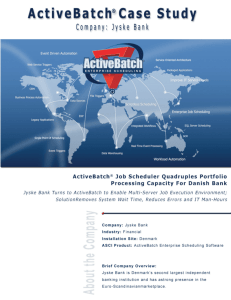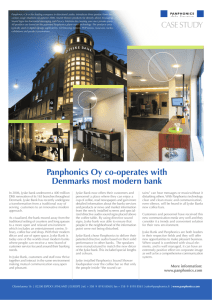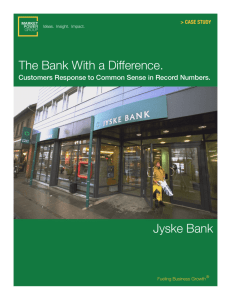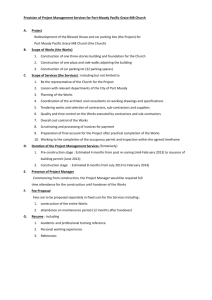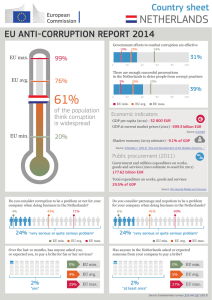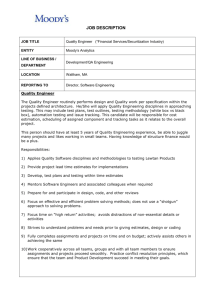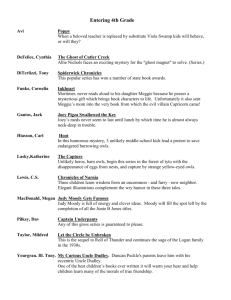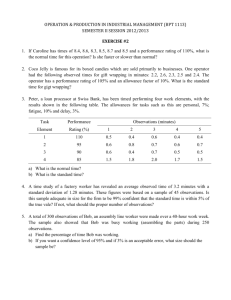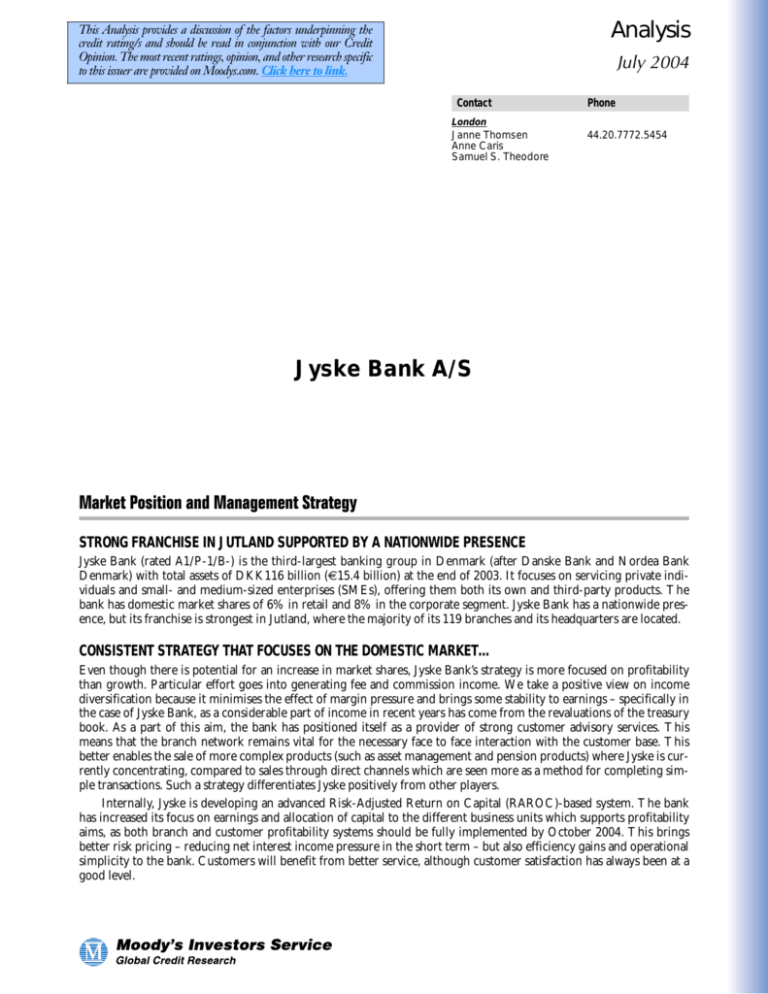
Analysis
This Analysis provides a discussion of the factors underpinning the
credit rating/s and should be read in conjunction with our Credit
Opinion. The most recent ratings, opinion, and other research specific
to this issuer are provided on Moodys.com. Click here to link.
July 2004
Contact
Phone
London
Janne Thomsen
Anne Caris
Samuel S. Theodore
44.20.7772.5454
Jyske Bank A/S
Market Position and Management Strategy
STRONG FRANCHISE IN JUTLAND SUPPORTED BY A NATIONWIDE PRESENCE
Jyske Bank (rated A1/P-1/B-) is the third-largest banking group in Denmark (after Danske Bank and Nordea Bank
Denmark) with total assets of DKK116 billion (€15.4 billion) at the end of 2003. It focuses on servicing private individuals and small- and medium-sized enterprises (SMEs), offering them both its own and third-party products. The
bank has domestic market shares of 6% in retail and 8% in the corporate segment. Jyske Bank has a nationwide presence, but its franchise is strongest in Jutland, where the majority of its 119 branches and its headquarters are located.
CONSISTENT STRATEGY THAT FOCUSES ON THE DOMESTIC MARKET…
Even though there is potential for an increase in market shares, Jyske Bank’s strategy is more focused on profitability
than growth. Particular effort goes into generating fee and commission income. We take a positive view on income
diversification because it minimises the effect of margin pressure and brings some stability to earnings – specifically in
the case of Jyske Bank, as a considerable part of income in recent years has come from the revaluations of the treasury
book. As a part of this aim, the bank has positioned itself as a provider of strong customer advisory services. This
means that the branch network remains vital for the necessary face to face interaction with the customer base. This
better enables the sale of more complex products (such as asset management and pension products) where Jyske is currently concentrating, compared to sales through direct channels which are seen more as a method for completing simple transactions. Such a strategy differentiates Jyske positively from other players.
Internally, Jyske is developing an advanced Risk-Adjusted Return on Capital (RAROC)-based system. The bank
has increased its focus on earnings and allocation of capital to the different business units which supports profitability
aims, as both branch and customer profitability systems should be fully implemented by October 2004. This brings
better risk pricing – reducing net interest income pressure in the short term – but also efficiency gains and operational
simplicity to the bank. Customers will benefit from better service, although customer satisfaction has always been at a
good level.
…. WITH SMALL FOREIGN TWIST
Jyske Bank additionally has subsidiaries in Switzerland (Zurich) and Gibraltar; branches in London, Hamburg, Fuengirola (Spain), Cannes and Warsaw. Most recently (in May 2004) it agreed to buy a 60% stake in a Dutch asset management firm, Berben's Effectenkantoor B.V. Although the non-Danish operations concentrate primarily on private
banking and asset management business, they also include some lending activities, including mortgages in Spain and
southern France, some Lombard lending to high net worth individuals with appropriate haircuts and a very modest
amount of commercial lending in Gibraltar. Jyske has a strong track record in its businesses abroad, and we feel confident about the foreign operations although several of them were launched or taken over fairly recently (i.e. businesses
based in Cannes, Warsaw, Echt [the Netherlands]).
CO-OPERATION WITH NYKREDIT CONTINUES AFTER THE TOTALKREDIT ACQUISITION
Jyske and Nykredit, Denmark’s largest mortgage provider, have had a co-operation agreement since 2002, in which
Nykredit’s retail products are offered through Jyske Bank’s branch networks alongside those of Totalkredit and DLR
Kredit (see separate Moody’s reports). The co-operation is being continued after Totalkredit’s 106 stakeholder banks
agreed to sell their shares to Nykredit in June 2003. The sale of 55% of Jyske’s 20.46% stake augmented its 2003 result
by DKK533 million.
In addition to the mortgage offering, Jyske and Nykredit have established a joint IT company in Denmark with
the aim of reducing Jyske’s IT costs by an annual amount l of DKK50 million over the years. [Please see page 1]
PROTECTED FROM HOSTILE TAKEOVER
Jyske’s strategy is to remain independent. This is supported by the bank’s legal status, which protects the bank from
hostile takeovers. Its some 36 million shares (Year-end 2003) each carry one vote, but each shareholder is allowed a
maximum 2,000 votes. Bearing in mind that 43% of shareholders own 1,000 (or fewer) shares, a hostile takeover would
be highly unlikely, or alternatively extremely expensive. Positively, such protection has not led to relaxation on the part
of management, who has continuously delivered satisfactory financial results.
CORPORATE GOVERNANCE
Jyske Bank largely complies with the corporate governance rules set by the Copenhagen Stock Exchange. However,
those related to voting rights are not in line with the bank’s strategy (see above) and are thus not followed.
Jyske Bank's shareholders elect 25-50 representatives from three geographical regions at the annual general meeting. Each region is represented by two members in the Supervisory Board, and three employee representatives. The
Board elects its own chairman and appoints the Management Board in charge of day-to-day operations
Financial Fundamentals
INCREASED PROFITABILITY ENHANCED BY GAINS FROM THE TOTALKREDIT SALE
In 2003, Jyske bank’s risk-weighted recurring earning power (pre-provision income as a percentage of average riskweighted assets) rose to 2.51% (2% in 2002). This calculation excludes the DK533 million gain on the Totalkredit sale.
Further gains from the sale are expected until 2012, although they are rapidly diminishing in size (gains of around
DKK250 million are forecast in 2004, decreasing to less than DKK50 million in 2007).
An item that traditionally brings volatility to Danish banks’ earnings is the obligatory market valuation of treasury
positions. In contrast to many others, Jyske has had a positive result on its position through the years, steadily increasing in the past three years to contribute nearly 15% of operating income at year-end 2003. We note, however, that
excluding this volatile line from calculations, the pre-provision income based profitability measures have been improving.
FEE AND COMMISSION INCOME IS INCREASING ACCORDING TO PLAN
Jyske Bank’s strategic emphasis on selling fee- and commission-generating products, such as investment fund management, has been successful in that the fee and commission income rose by over 20% in 2003. However, a large part of
fees and commissions are generated from distributing Nykredit’s (as well as Totalkredit’s and DLR’s) mortgage products. In the medium term, we believe that this income source will remain stable and that the co-operation with
Nykredit will continue as usual.
2
Moody’s Analysis
Increasing fee and commission is generally viewed positively by Moody’s; and being more stable than trading
income, it stabilises revenue streams and eases the pressure that banks face when the capital markets receive a severe
hit (as in 2002) or when interest rates decrease and margins are under pressure (as in all Nordic countries recently). It
is worth noting, that Jyske Bank has been quite successful in its risk-pricing initiative. Net interest margin also rose in
2003 as the Totalkredit-related mortgage portfolio was removed from Jyske’s balance sheet. This is because the mortgage market is extremely competitive in Denmark, thus mortgage loans suffer from extremely low margins.
ADEQUATE EFFICIENCY REFLECTS STRATEGY
The cost-to-income ratio improved to 57% in 2003 (61% in 2002). However, the improvement is attributable to the
revenue side of the equation, as the bank’s cost base actually increased. Personnel costs rose by 9% together with the
increasing employee numbers which is in line with the focus on advisory services. In other areas, cost-containment was
relatively good considering the on-going branch restructuring and the investment in enhancing IT systems and organisational changes mainly related the RAROC project. We acknowledge that these investments potentially bring cost
benefits in the longer term, and we have no concerns with Jyske’s current level of efficiency in that respect.
SOLID ASSET QUALITY
Jyske Bank demonstrates solid asset quality. Problem loans as a percentage of gross loans rose marginally to 0.5% following the shrinkage of the portfolio due to sale of Totalkredit. This is due to the fact that the quality of the
Totalkredit-related portfolio was extremely good, and although Jyske’s own credit quality is sound, the relative measure rose together with the decrease in gross loans. Problem loan coverage remained extremely strong at over 600%.
Credit exposure is overwhelmingly to Danish customers (85%). Only 42% of lending is to private individuals, but we
have no major qualms about the rest of the portfolio, which is well diversified. In addition, the granularity of the portfolio is in line with majority of other single A rated banks in Europe and none of the larger exposures are rated high
risk. We regard Jyske Bank's solid asset quality as a key rating driver.
Market risk, mainly currency and interest rate risk, lies within the activities of the group treasury, Jyske Markets,
plus some domestic activities. It is managed in the treasury, and conservative limits are set by the Supervisory Board,
which on rare occasions authorises the breaching of these limits. To quantify its market risk Jyske Bank employees a
Value-at-risk model (VaR) with a holding period of one day and a 99% confidence level. This is defined as a 99% Daily
Earnings-at-risk (DEaR) At the end of 2003, DEaR on the total market risk portfolio corresponded to about 0.2% of
shareholders’ funds. The VaR model is back-tested daily against revenue from market-risk related positions, and
stress-testing of positions is done monthly. We note that the enhancement of systems and risk management in the bank
has resulted in more stable and lower levels of market risk in the bank during the past two to three years. Considering
the extent of Jyske’s treasury activities, market risk is at acceptable level.
FUNDING BASE IS DIVERSIFIED AND LIQUIDITY IS GOOD
Jyske Bank's funding sources are well diversified, with almost 60% of funding derived from customer deposits and
nearly 25% from medium- and long-term market funding. We view positively the relatively low level of interbank
funding given the more volatile nature of these deposits. From a liquidity standpoint the group holds a portfolio of
marketable securities, which at the end of 2003 stood at approximately DKK22 billion, very comfortably covering the
bank's interbank funds. In total, over 27% of total assets are liquid assets.
GOOD ECONOMIC CAPITALISATION
At the end of the first quarter 2004, Jyske Bank’s Tier 1 ratio was 9.1% and total capital ratio 11.3%, which are well
above their internal targets. In June 2004, Jyske took advantage of the currently favourable markets, issuing €125 million of hybrid Tier 1 capital, which further strengthens the regulatory ratios. However, discounting the hybrid elements, considering the good risk profile, Jyske Bank’s true economic capital remains strong. As at 31st May 2004 Jyske
Bank’s Tier 1 ratio excluding hybrid tier 1 capital but including interim retained earnings would have been 9.6%.
Moody’s Analysis
3
Related Research
Analysis:
Totalkredit A/S, June 2004 (87275)
Nykredit Realkredit A/S, June 2004 (87495)
DLR Kredit A/S, May 2004 (87006)
Banking System Outlook:
Denmark, December 2003 (80704)
Banking Statistical Supplement:
Denmark, July 2004 (87525)
To access any of these reports, click on the entry above. Note that these references are current as of the date of publication of this
report and that more recent reports may be available. All research may not be available to all clients.
4
Moody’s Analysis
Jyske Bank A/S (Consolidated)
31/12/2003
31/12/2002
31/12/2001
31/12/2000
31/12/1999
Cash & central bank
Due from banks
Securities
Gross loans
Loan loss reserves (LLR)
Insurance assets
Fixed assets
Other assets
Total assets
Total assets (USD million) [1]
Total assets (EUR million)
5,332
8,317
22,134
65,797
(2,036)
0
1,647
15,235
116,425
19,634
15,642
4,975
7,786
24,785
97,359
(2,058)
0
1,522
18,800
153,169
21,621
20,629
4,094
7,027
25,647
84,457
(1,920)
0
1,482
12,368
133,156
15,786
17,831
5,384
8,573
22,102
77,204
(1,842)
0
1,376
14,562
127,359
16,066
17,053
4,332
7,764
19,877
51,508
(1,780)
0
1,280
9,515
92,495
12,482
12,423
Demand deposits
Savings deposits [2]
Due to banks
Market funds
Insurance liabilities
Other liabilities
Total liabilities
Subordinated debt
Shareholders' equity
Total capital funds
Total liabilities & capital funds
38,621
25,195
13,929
8,064
0
20,935
106,743
1,809
7,843
9,682
116,425
33,284
25,679
17,210
43,362
0
24,378
143,912
2,600
6,658
9,258
153,169
29,284
25,109
17,484
36,964
0
15,442
124,283
2,663
6,174
8,873
133,156
24,390
27,877
22,380
26,902
0
17,781
119,331
2,110
5,887
8,028
127,359
23,223
26,590
25,124
192
0
10,550
85,678
1,395
5,391
6,816
92,495
1,081,513
10,518
19,404
75,791
1,010,697
13,500
17,247
84,186
1,692,781
7,347
17,310
79,798
1,574,989
15,404
74,216
1,153,852
14,426
62,137
26,700
19,900
20,000
16,000
-
3,547
3,359
3,418
3,190
3,013
5,334
2,788
2,547
872
924
0
374
4,717
1,649
923
2,145
139
2,711
2,006
400
203
0
1,809
525
1,284
0
1,284
6,394
3,748
2,646
565
758
0
267
4,237
1,507
941
1,789
150
2,598
1,639
408
(148)
0
1,083
572
511
0
511
6,796
4,346
2,450
303
668
0
311
3,731
1,385
908
1,437
149
2,442
1,288
286
(112)
0
890
267
624
4
619
5,847
3,712
2,135
594
760
0
231
3,719
1,234
789
1,696
119
2,142
1,577
318
(5)
0
1,255
172
1,083
(0)
1,083
3,913
1,888
2,025
683
646
0
227
3,582
1,130
706
1,746
168
2,004
1,577
258
(44)
0
1,276
379
897
(1)
898
(32.42)
(23.99)
8.23
(3.76)
21.84
4.34
22.43
151.19
15.28
15.03
8.40
8.03
13.59
6.39
27.20
(17.48)
9.39
4.55
4.07
14.74
(12.10)
14.00
(18.31)
(42.82)
49.89
37.69
4.93
5.43
17.63
6.90
(0.03)
20.59
24.61
20.30
13.69
(0.57)
8.70
17.04
74.02
77.96
Summary Balance Sheet (DKK million)
Derivatives - notional amount
Derivatives - replacement value
Contingent liabilities
Risk weighted assets (RWA)
Assets under management (DKK million) [3]
Number of employees
Summary Income Statement
+Interest income
-Interest expense
=Net interest income
+Trading income
+Fee & commission income
+Insurance income (net)
+Other operating income
=Operating income
-Personnel expenses
-Other operating expenses
= Operating funds flow
-Amortisation/depreciation
(Total operating expenses)
=Preprovision income (PPI)
-Loan loss provisions
+Other non operating adjustments [4]
+Extraordinary profit / loss
=Pretax income
-Taxes
=Net income
-Minority interests
=Net income (group share)
Growth Rates (%)
Gross loans
Total assets
Customer deposits (demand and savings)
Net interest income
Fee and commission income
Operating expenses
Preprovision income
Net income
Moody’s Analysis
5
Jyske Bank A/S (Consolidated)
31/12/2003
31/12/2002
31/12/2001
31/12/2000
31/12/1999
3.18
1.09
1.16
5.90
3.39
2.51
0.50
1.61
3.23
0.69
0.93
5.17
3.17
2.00
0.50
0.62
3.18
0.39
0.87
4.84
3.17
1.67
0.37
0.81
3.13
0.87
1.11
5.46
3.14
2.31
0.47
1.59
3.52
1.19
1.12
6.23
3.49
2.74
0.45
1.56
27.20
60.52
58.54
14.85
24.52
2.10
59.73
132.89
(19.78)
59.34
25.95
63.50
48.52
14.85
34.38
2.25
65.56
160.39
3.26
57.27
27.95
62.05
49.57
18.53
29.68
2.22
68.28
151.57
(6.20)
59.12
30.94
58.54
56.65
26.36
15.04
1.95
66.64
126.09
(39.93)
62.02
35.35
54.81
67.43
30.66
0.59
1.32
63.96
99.16
(67.40)
67.86
53.99
18.49
19.59
0.00
7.94
62.46
13.34
17.90
0.00
6.30
65.66
8.11
17.90
0.00
8.33
57.40
15.98
20.42
0.00
6.20
56.54
19.08
18.03
0.00
6.35
4.78
2.66
2.32
1.49
2.51
1.19
2.01
0.95
1.61
20.78
16.37
6.37
19.93
38.35
19.28
0.00
5.16
3.21
2.13
1.14
2.00
0.86
1.50
0.36
0.62
17.83
7.68
6.49
24.88
25.56
8.28
0.00
6.01
4.04
2.17
0.99
1.67
0.77
1.30
0.48
0.81
15.90
10.03
8.56
22.20
23.87
10.52
0.00
6.23
4.12
2.27
1.43
2.31
1.15
1.85
0.99
1.59
21.21
18.40
6.72
20.15
33.73
20.09
0.00
5.30
2.72
2.74
1.86
2.74
1.56
2.30
1.06
1.56
25.89
16.66
7.85
16.36
35.61
15.00
14.70
57.47
2.01
1,329.91
764.30
565.62
61.32
1.81
1,261.40
773.53
487.87
65.47
1.87
1,091.47
714.54
376.93
57.60
1.95
1,165.94
671.58
494.37
55.96
2.37
1,188.68
665.13
523.55
0.50
617.62
3.09
0.61
3.34
134.11
0.36
594.76
2.11
0.42
3.97
202.77
0.46
494.28
2.27
0.34
4.80
119.00
0.35
679.38
2.39
0.41
3.51
0.00
0.63
552.21
3.46
0.50
4.50
0.00
10.20
12.40
6.74
0.16
8.20
11.30
4.35
5.47
7.90
11.40
4.64
7.79
8.00
11.00
4.62
9.53
8.20
10.50
5.83
2.15
Income Statement in % Average Risk Weighted Assets
Net interest income
Trading income
Fee and commission income
Insurance income
Operating income
Operating expenses
Preprovision income
Loan loss provisions
Extraordinary profit
Net income
Liquidity, Funding (including sub debt) & Balance Sheet Composition
Avg. liquid assets % avg. total assets
Avg. gross loans % avg. total assets
Avg. customer deposits % avg. total funding
Avg. interbank funds % avg. total funding
Avg. market funds (excl. interbank) % avg. total funding
Avg. sub debt % avg. total funding
Avg. liquid assets % avg. customer deposits
Avg. gross loans % avg. customer deposits
Avg. market funds reliance [5]
Avg. RWA % avg. total assets
Breakdown of Operating Income in %
Net interest income % operating income
Trading income % operating income
Fee & commission income % operating income
Insurance income % operating income
Other operating income % operating income
Profitability
Yield on avg. earning assets (%)
Cost of interest bearing liabilities (%)
Net interest margin (%)
Recurring earning power (PPI % avg. assets)
Risk-weighted recurring earning power (PPI % avg. RWA)
Post-provision income % avg. assets
Post-provision income % avg. risk weighted assets
Return on average assets (%)
Return on avg. RWA (%)
Post-provision income % tier 1 capital
Return on equity (period end) (%)
Net interest income coverage of loan loss provisions
Loan loss provisions % preprovision income
Pre-tax income % operating income
Internal capital growth (%)
Dividend payout ratio (%)
Efficiency
Cost/income ratio (operating expenses % operating income)
Operating expenses % average assets
Operating income / employee (DKK thousand)
Operating expenses / employee (DKK thousand)
PPI / employee (DKK thousand)
Asset Quality and Risk Measurement
Problem loans % gross loans
LLR % problem loans
LLR % gross loans
Loan loss provisions % gross loans
Problem loans % (shareholders' equity + LLR)
Replacement value % shareholder's equity
Capital Adequacy (Period End)
Tier 1 ratio (%)
Total capital ratio (%)
Shareholders' equity % total assets
Equity participations % shareholders' equity
[1] Historical exchange rates are applied accordingly for USD and EUR figures.
[2] Full disclosure may not be available for all years. The amount is then included in "demand deposits".
[3] As reported by the bank
[4] This may include value adjustments of securities.
[5] Avg. [(market funds-liquid assets) % (earning assets-liquid assets)]
6
Moody’s Analysis
Description
Coupon (%)
Currency
—
—
—
—
—
—
—
—
—
—
4.800
—
—
—
—
5.650
5.670
7.000
6.725
—
—
—
—
USD
EUR
USD
EUR
EUR
EUR
EUR
EUR
EUR
EUR
EUR
EUR
EUR
EUR
EUR
EUR
EUR
EUR
EUR
USD
—
—
—
Face Amount (mil)
Maturity
Moody's Rating
2005
2005
2005
2006
2007
2007
2008
2010
2010
2011
2018
2008
2009
2009
2023
2023
2023
2024
2026
—
—
—
—
A1
A1
A1
A1
A1
A1
A1
A1
A1
A1
A1
A2
A2
A2
A2
A2
A2
A2
A2
A1/A2/P-1
A1
BP-1
Jyske Bank A/S
Flt Rt Euro Medium Term Notes
Flt Rt Euro Medium Term Notes
Flt Rt Euro Medium Term Notes
Flt Rt Euro Medium Term Notes
Flt Rt Euro Medium Term Notes
Flt Rt Euro Medium Term Notes
Flt Rt Euro Medium Term Notes
Flt Rt Euro Medium Term Notes
Flt Rt Euro Medium Term Notes
Flt Rt Euro Medium Term Notes
Euro Medium Term Notes
Sub. Flt Rt Euro Medium Term Notes
Sub. Euro Medium Term Notes
Sub. Euro Medium Term Notes
Sub. Flt Rt Euro Medium Term Notes
Sub. Euro Medium Term Notes
Sub. Euro Medium Term Notes
Sub. Fix/Flt Rt. Euro Medium Term Notes
Sub. Euro Medium Term Notes
Euro MTN Program
Long-Term Bank Deposit Rating
Bank Financial Strength Rating
Short-Term Bank Deposit Rating
Rating History
10
45
30
300
8
15
300
50
10
50
20
125
25
10
10
10
10
25
15
1,000
—
—
—
Long-term Bank Deposits
$D
$
$
$
Moody’s Analysis
7
To order reprints of this report (100 copies minimum), please call 1.212.553.1658.
Report Number: 88170
Author
Editor
Statistical Analyst
Production Associate
Anna Nikula
Wendy Arthur
Olivier Sueur
David Ainsworth
© Copyright 2004, Moody’s Investors Service, Inc. and/or its licensors including Moody’s Assurance Company, Inc. (together, “MOODY’S”). All rights reserved. ALL INFORMATION
CONTAINED HEREIN IS PROTECTED BY COPYRIGHT LAW AND NONE OF SUCH INFORMATION MAY BE COPIED OR OTHERWISE REPRODUCED, REPACKAGED, FURTHER
TRANSMITTED, TRANSFERRED, DISSEMINATED, REDISTRIBUTED OR RESOLD, OR STORED FOR SUBSEQUENT USE FOR ANY SUCH PURPOSE, IN WHOLE OR IN PART, IN ANY
FORM OR MANNER OR BY ANY MEANS WHATSOEVER, BY ANY PERSON WITHOUT MOODY’S PRIOR WRITTEN CONSENT. All information contained herein is obtained by
MOODY’S from sources believed by it to be accurate and reliable. Because of the possibility of human or mechanical error as well as other factors, however, such information is provided “as
is” without warranty of any kind and MOODY’S, in particular, makes no representation or warranty, express or implied, as to the accuracy, timeliness, completeness, merchantability or fitness
for any particular purpose of any such information. Under no circumstances shall MOODY’S have any liability to any person or entity for (a) any loss or damage in whole or in part caused by,
resulting from, or relating to, any error (negligent or otherwise) or other circumstance or contingency within or outside the control of MOODY’S or any of its directors, officers, employees or
agents in connection with the procurement, collection, compilation, analysis, interpretation, communication, publication or delivery of any such information, or (b) any direct, indirect,
special, consequential, compensatory or incidental damages whatsoever (including without limitation, lost profits), even if MOODY’S is advised in advance of the possibility of such
damages, resulting from the use of or inability to use, any such information. The credit ratings and financial reporting analysis observations, if any, constituting part of the information
contained herein are, and must be construed solely as, statements of opinion and not statements of fact or recommendations to purchase, sell or hold any securities. NO WARRANTY,
EXPRESS OR IMPLIED, AS TO THE ACCURACY, TIMELINESS, COMPLETENESS, MERCHANTABILITY OR FITNESS FOR ANY PARTICULAR PURPOSE OF ANY SUCH RATING OR OTHER
OPINION OR INFORMATION IS GIVEN OR MADE BY MOODY’S IN ANY FORM OR MANNER WHATSOEVER. Each rating or other opinion must be weighed solely as one factor in any
investment decision made by or on behalf of any user of the information contained herein, and each such user must accordingly make its own study and evaluation of each security and of
each issuer and guarantor of, and each provider of credit support for, each security that it may consider purchasing, holding or selling.
MOODY’S hereby discloses that most issuers of debt securities (including corporate and municipal bonds, debentures, notes and commercial paper) and preferred stock rated by
MOODY’S have, prior to assignment of any rating, agreed to pay to MOODY’S for appraisal and rating services rendered by it fees ranging from $1,500 to $2,300,000. Moody’s Corporation
(MCO) and its wholly-owned credit rating agency subsidiary, Moody’s Investors Service (MIS), also maintain policies and procedures to address the independence of MIS’s ratings and rating
processes. Information regarding certain affiliations that may exist between directors of MCO and rated entities, and between entities who hold ratings from MIS and have also publicly
reported to the SEC an ownership interest in MCO of more than 5%, is posted annually on Moody’s website at www.moodys.com under the heading “Shareholder Relations — Corporate
Governance — Director and Shareholder Affiliation Policy.”
8
Moody’s Analysis

